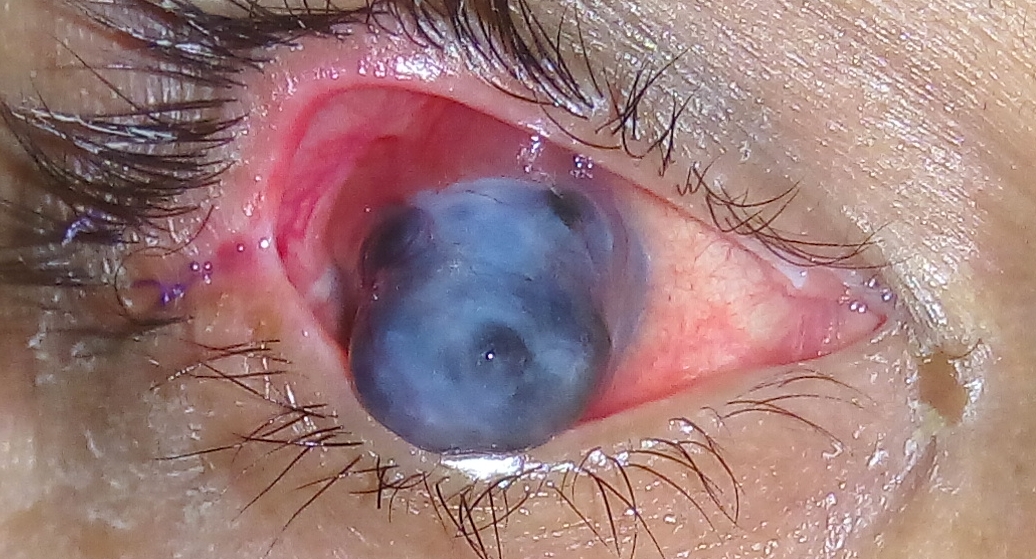Staphyloma on:
[Wikipedia]
[Google]
[Amazon]
A staphyloma is an abnormal protrusion of the
 In the
In the
 As the name implies, it is the bulge of weak sclera lined by ciliary body, which occurs about 2–3 mm away from the limbus. Its common causes are thinning of sclera following perforating injury, scleritis & absolute glaucoma.
It is a part of anterior staphyloma.
As the name implies, it is the bulge of weak sclera lined by ciliary body, which occurs about 2–3 mm away from the limbus. Its common causes are thinning of sclera following perforating injury, scleritis & absolute glaucoma.
It is a part of anterior staphyloma.
 In the
In the
uvea
The uvea (; derived from meaning "grape"), also called the uveal layer, uveal coat, uveal tract, vascular tunic or vascular layer, is the pigmented middle layer of the three concentric layers that make up an eye, precisely between the inne ...
l tissue through a weak point in the eyeball
An eye is a sensory organ that allows an organism to perceive visual information. It detects light and converts it into electro-chemical impulses in neurons (neurones). It is part of an organism's visual system.
In higher organisms, the eye ...
. The protrusion is generally black in colour, due to the inner layers of the eye. It occurs due to weakening of outer layer of eye (cornea or sclera) by an inflammatory or degenerative condition.
It may be of five types, depending on the location on the eyeball (''bulbus oculi'').
Anterior (corneal) staphyloma
 In the
In the anterior segment
The anterior segment or anterior cavity is the front third of the eye that includes the structures in front of the vitreous humour: the cornea, iris, ciliary body, and lens
A lens is a transmissive optical device that focuses or dispers ...
of the eye, involving the cornea
The cornea is the transparency (optics), transparent front part of the eyeball which covers the Iris (anatomy), iris, pupil, and Anterior chamber of eyeball, anterior chamber. Along with the anterior chamber and Lens (anatomy), lens, the cornea ...
and the nearby sclera
The sclera, also known as the white of the eye or, in older literature, as the tunica albuginea oculi, is the opaque, fibrous, protective outer layer of the eye containing mainly collagen and some crucial elastic fiber.
In the development of t ...
. It is an ectasia and outpouching of the pseudocornea ( the scar formed from organised exudates and fibrous tissue covered with epithelium over the iris) which results after total sloughing of cornea in sloughening corneal ulcer with iris plastered behind; the pseudocornea, being too weak to resist the IOP protrudes forward with the uveal tissue. This is known as anterior staphyloma.
Intercalary staphyloma
It is the name given to the localised bulge in limbal area, lined by the root of the iris. It results due to ectasia of weak scar tissue formed at the limbus, following healing of a perforating injury or a peripheral corneal ulcer. There may be associated secondary angle closure glaucoma, may cause progression of the bulge if not treated. Defective vision occurs due to marked corneal astigmatism. Treatment consists of localised staphylectomy under heavy doses of oral steroids.Ciliary staphyloma
 As the name implies, it is the bulge of weak sclera lined by ciliary body, which occurs about 2–3 mm away from the limbus. Its common causes are thinning of sclera following perforating injury, scleritis & absolute glaucoma.
It is a part of anterior staphyloma.
As the name implies, it is the bulge of weak sclera lined by ciliary body, which occurs about 2–3 mm away from the limbus. Its common causes are thinning of sclera following perforating injury, scleritis & absolute glaucoma.
It is a part of anterior staphyloma.
Equatorial staphyloma
On the equator of the eye (region circumferencing the largest diameter orthogonal to the visual axis). Its causes are scleritis & degeneration of sclera in pathological myopia. It occurs more commonly in the regions of sclera which are perforated by vortex veins.Posterior staphyloma
 In the
In the posterior segment
The posterior segment or posterior cavity is the back two-thirds of the eye that includes the anterior hyaloid membrane and all of the optical structures behind it: the vitreous humor, retina, choroid, and optic nerve.optic nerve
In neuroanatomy, the optic nerve, also known as the second cranial nerve, cranial nerve II, or simply CN II, is a paired cranial nerve that transmits visual system, visual information from the retina to the brain. In humans, the optic nerve i ...
or macula
The macula (/ˈmakjʊlə/) or macula lutea is an oval-shaped pigmented area in the center of the retina of the human eye and in other animals. The macula in humans has a diameter of around and is subdivided into the umbo, foveola, foveal avas ...
, deforming the eye in a way that the eye-length is extended associated with myopia
Myopia, also known as near-sightedness and short-sightedness, is an eye condition where light from distant objects focuses in front of, instead of on, the retina. As a result, distant objects appear blurry, while close objects appear normal. ...
(nearsightedness). It is diagnosed by ophthalmoscopy, which shows an area of retinal excavation in the region of the staphyloma.
References
{{Medicine Eye diseases